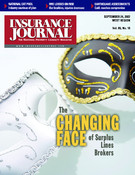Since the devastating hurricane seasons of 2004 and 2005, some Florida politicians and a few insurers have claimed that the private insurance industry cannot pay for natural disaster losses without the support of a system of state and federal natural catastrophe reinsurance funds.
Ultimately, the debate is about who will pay for the inevitable damage. Most of those who don’t live at the beach or in earthquake-exposed areas don’t want to subsidize others to live in highly catastrophe exposed places. Insurance premiums for those facing natural catastrophe risk should reflect the true cost of their chosen lifestyles.
The private insurance market can pay and has recently paid extraordinary natural catastrophe losses. It is the most efficient way to address and insure risk. Consumers do not want to be financially devastated if their homes are destroyed by a catastrophe. They buy insurance to transfer that risk to insurers. In exchange, insurers are willing to assume that risk for a set premium and a fair chance of a profit.
Most private insurers diversify their risk exposures over multiple states or countries. They also manage their risk by transferring some risk to reinsurers who further spread the risk of loss throughout the global insurance and reinsurance markets. When a catastrophe occurs, insurers and their reinsurers pay the losses, providing an economic stimulus at the time it is most needed.
Despite the fact that insurers paid an estimated $90 billion in catastrophe losses for 2004 and 2005 hurricanes, investors indicated their appetite for risk by injecting more than $40 billion into the reinsurance market and related capital markets products. In addition, efforts to create a catastrophe derivatives market were recently consummated by the first trade on the NY Mercantile Exchange. That influx of capital has already triggered increased competition and reinsurance price reductions.
In contrast, the supporters of government funds, like alchemists, believe they can make gold out of public debt. They suggest that government can ignore the most fundamental principle of risk management — that risk should be transferred and spread, not concentrated. They claim that concentrating risk in government funds, backed by bonds paid off by consumers, will enable the fund to grow, while lowering insurance costs for consumers. Additionally the proponents raise false hopes that government funds will have excess monies to pay for a host of disaster prevention and preparedness needs.
To prove their case, the proponents used a respected actuarial firm to demonstrate the savings from a system of state and federal catastrophe funds. The illusory savings were achieved by various assumptions and a focus on the long term — over thousands of years! Any study that implies consumers and taxpayers have thousands of years to realize savings is immediately suspect. It breathes life into the Disraeli quote, “There are three kinds of lies: Lies, damned lies, and statistics.”
The advocates also neglect to say that the principal beneficiaries of government funds are insurers themselves. At the same time as they claim the funds are needed for huge risks, advocates seek to have government coverage attach at a low level with inevitable shortfalls funded by taxes on insurance policyholders. Unwitting consumers become the insurers of their own insurers. Insurance takes risk away from consumers. Catastrophe funds put it back on policyholders — and not just those exposed to the risk. Catastrophe funds make everyone pay to enable those most exposed to pay less.
Affordability of insurance for low and fixed income consumers is a concern. States should consider consumer subsidies based on financial need. Such subsidies should be transparent and separate from the insurance mechanism.
A review of the only state catastrophe fund in operation, the Florida Hurricane Catastrophe Fund (the “Cat Fund”) reveals the truth about such funds. The Florida Cat Fund is not a success. The recent storms left it broke and in debt. Small businesses, churches, nonprofit organizations and automobile drivers are being taxed to pay off the debt the Cat Fund incurred after the 2004 and 2005 storms. Future fund losses will add to the debt tax on insurance policyholders. Despite having 12 years to build up capital after Hurricane Andrew, the Cat Fund did not have enough to pay claims without borrowing money.
As a result of diversification and risk spreading, the private property and casualty insurance industry, as a whole, was able to pay its 2004 and 2005 hurricane catastrophe losses out of earnings, not surplus.
The private insurance approach charges those at risk an appropriate premium and does not involve deficit financing or subsidies from others. The government fund concept requires both. Unlike public insurance programs, free market pricing also encourages mitigation and serves as a risk gauge to those that might consider building in harm’s way.
While “there is no free lunch,” private market competition will give consumers risk transfer choices at a lower cost than government solutions. Let the free market work.
Dennis C. Burke is vice president, state relations for the Reinsurance Association of America, where his responsibilities include legislative and regulatory issues in the 50 states.
Was this article valuable?
Here are more articles you may enjoy.


 NC Insurance Commissioner Urges President to Not Pardon Greg Lindberg
NC Insurance Commissioner Urges President to Not Pardon Greg Lindberg  Florida Insurance Agency VP Sentenced to 3 Years in Massive ACA Fraud Scheme
Florida Insurance Agency VP Sentenced to 3 Years in Massive ACA Fraud Scheme  CEOs on Guard as Trump Rattles Companies With Series of Edicts
CEOs on Guard as Trump Rattles Companies With Series of Edicts  Relief But Questions on Agents’ Duties to Insureds After Florida Court Ruling
Relief But Questions on Agents’ Duties to Insureds After Florida Court Ruling 


